Idaho Territory
The Territory of Idaho was an organized incorporated territory of the United States that existed from March 3, 1863, until July 3, 1890, when the final extent of the territory was admitted to the Union as Idaho.
| Territory of Idaho | |||||||||||||||||
|---|---|---|---|---|---|---|---|---|---|---|---|---|---|---|---|---|---|
| Organized incorporated territory of the United States | |||||||||||||||||
| 1863–1890 | |||||||||||||||||
.jpg) Coat of arms of the Idaho Territory (1863–1866)
| |||||||||||||||||
| Capital | Lewiston (1863–1866) Boise (1866–1890) | ||||||||||||||||
| • Type | Organized incorporated territory | ||||||||||||||||
| History | |||||||||||||||||
| March 3 1863 | |||||||||||||||||
| May 28, 1864 | |||||||||||||||||
• Wyoming Territory formed | July 25, 1868 | ||||||||||||||||
| July 3 1890 | |||||||||||||||||
| |||||||||||||||||
.jpg)
History
| Year | Pop. | ±% |
|---|---|---|
| 1870 | 14,999 | — |
| 1880 | 32,610 | +117.4% |
| 1890 | 88,548 | +171.5% |
| Source: 1870–1890;[1] | ||
1860s
The territory was officially organized on March 3, 1863, by Act of Congress,[2] and signed into law by President Abraham Lincoln. It is a successor region that was created by areas from existing territories undergoing parallel political transitions beginning with disputes over which country owned the region (See Oregon Country). By 1863 the area west of the Continental Divide that was formerly part of the huge Oregon Territory (by now some was a state) had been sundered from the coastal Washington Territory north of the young State of Oregon to the far west and the remnant of the Oregon Territory was officially "unorganized".— Most of the area east of the Continental Divide had been part of the loosely defined Dakota Territory ending along the 49th parallel—now the border with Canada, then a colonial possession of Great Britain.
The original newly organized territory covered all of the present-day states of Idaho and Montana, and almost all of the present-day state of Wyoming, omitting only a corner in the state's extreme southwest portion. It was wholly spanned east-to-west by the bustling Oregon Trail and partly by the other emigrant trails, the California Trail and Mormon Trail which since hitting stride in 1847, had been conveying settler wagon trains to the west, and incidentally, across the continental divide into the Snake River Basin, a key gateway into the Idaho and Oregon Country interiors.
The first territorial capital was at Lewiston[3] from the inception in 1863 to 1866. Boise was made the territorial capital from 1866 by a one-vote margin of the Territorial Supreme Court.
The upheaval caused by the Civil War and Reconstruction was a distant concern to those in the comparatively stable Idaho Territory, a situation which in turn encouraged settlement.
In 1864, the Montana Territory was organized from the northeastern section of the territory east of the Bitterroot Range. Most of the southeastern area of the territory was made part of the Dakota Territory.
In the late 1860s, Idaho Territory became a destination for displaced Southern Democrats who fought for the Confederate States of America during the Civil War. These people were well represented in the early territorial legislatures, which often clashed with the appointed Republican territorial governors. The political infighting became particularly vicious in 1867 when Governor David W. Ballard asked for protection from federal troops stationed at Fort Boise against the territorial legislature. By 1870, however, the political infighting had decreased considerably.
In 1868, the areas east of the 111th meridian west were made part of the newly created Wyoming Territory. Idaho Territory assumed the boundaries of the modern state at that time. The discovery of gold, silver and other valuable natural resources throughout Idaho beginning in the 1860s, as well as the completion of the Transcontinental Railroad in 1869, brought many new people to the territory, including Chinese laborers who came to work the mines. As Idaho approached statehood, mining and other extractive industries became increasingly important to its economy. By the 1890s, for example, Idaho exported more lead than any other state.
1870s
Construction began on the Idaho Territorial Prison in 1870 and was completed by 1872. The prison was in use by the territory, then the state until 1973. The Old Idaho State Penitentiary was placed on the National Register of Historic Places in 1974 for its significance as a Territorial Prison. The site currently contains museums and an arboretum.[4]
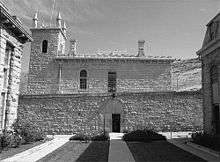
Almost immediately after Idaho Territory was created, a public school system was created and stage coach lines were established. Regular newspapers were active in Lewiston, Boise and Silver City by 1865. The first telegraph line reached Franklin in 1866, with Lewiston being the first town linked in northern Idaho in 1874. The first telephone call in the Pacific Northwest was made on May 10, 1878, in Lewiston.
Although forming a sizable minority, Members of the Church of Jesus Christ of Latter-Day Saints in Idaho were held in suspicion by others in Idaho. By 1882 notable and powerful Idahoans successfully disenfranchised Members of the Church of Jesus Christ of Latter-Day Saints voters in Idaho Territory, citing their illegal practice of polygamy. Idaho was able to achieve statehood some six years before Utah, a territory which had a larger population and had been settled longer, but was majority Members of the Church of Jesus Christ of Latter-Day Saints with voting polygamists.
There were four thousand Chinese living in the Idaho Territory from 1869 to 1875. Like many Chinese immigrants, they came to "Gold Mountain" to work as miners, or found work as laundrymen and cooks.[5] The 1870 census reported there were 1,751 Chinese in Idaho City who were nearly half of city residents.[6]
1880s
After the capital relocation controversy proposals to split the two regions became widespread. In 1887 Idaho Territory was nearly legislated out of existence, but as a favor to Governor Edward A. Stevenson, President Grover Cleveland refused to sign a bill that would have split Idaho Territory between Washington Territory in the north and Nevada in the south.
In 1889, the University of Idaho was awarded to the northern town of Moscow instead of its original planned location at Eagle Rock (now Idaho Falls) in the south. This served to alleviate some of the hard feelings felt by North Idaho residents over losing the capital.
The territory was admitted to the Union as the State of Idaho on July 3, 1890.
Territorial change
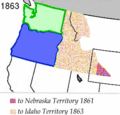 Old Washington Territory—and the portions ceded to Nebraska Territory on March 2, 1861, and to Idaho Territory in 1863.
Old Washington Territory—and the portions ceded to Nebraska Territory on March 2, 1861, and to Idaho Territory in 1863.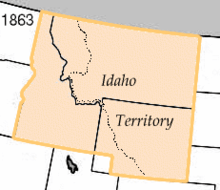 The Idaho Territory in 1863
The Idaho Territory in 1863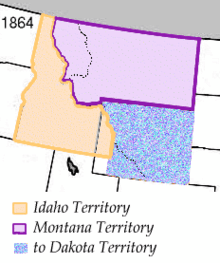
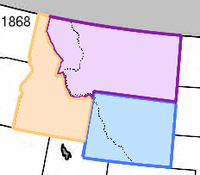 The Idaho, Montana, and Wyoming Territories in 1868
The Idaho, Montana, and Wyoming Territories in 1868
See also
- Idaho in the American Civil War
- California Trail
- Historic regions of the United States
- History of Idaho
- Oregon Trail
- Oregon Treaty, 1846
- Territorial evolution of the United States
- State of Deseret, 1849–1850 (extralegal)
- Territory of Jefferson, 1859–1861 (extralegal)
References
- Forstall, Richard L. (ed.). Population of the States and Counties of the United States: 1790–1990 (PDF) (Report). United States Census Bureau. p. 3. Retrieved May 18, 2020.
- 12 Stat. 808
- Idaho State Historical Society (1968). ""Territorial Government in Idaho, 1863-1869," Reference Series No. 48" (PDF). Archived from the original (PDF) on October 2, 2013. Retrieved September 29, 2013.
- "Old Idaho Penitentiary Timeline" (PDF). Education Programs. Idaho State Historical Society. 2007. Archived from the original (PDF) on May 29, 2008. Retrieved June 3, 2007.
- BOISE BASIN HISTORICAL SUMMARY
- Surviving on the gold mountain: a history of Chinese American women By Huping Ling
External links
| Wikimedia Commons has media related to Idaho Territory. |
- Idaho State Univ. document (PDF) on origin of name "Idaho" and how Idaho became territory
- COLUMBIA: Fall 1988; Vol. 2, No. 3, The Long Wait for Statehood, Why it took Washington 36 years and Idaho 26 years to achieve their goals.
- Idaho Organic Act 1863 – An Act to provide a temporary Government for the Territory of Idaho
- Laws of the Territory of Idaho (1864)
- Constitution of the state of Idaho, and the act providing for the admission of the state (1891)
